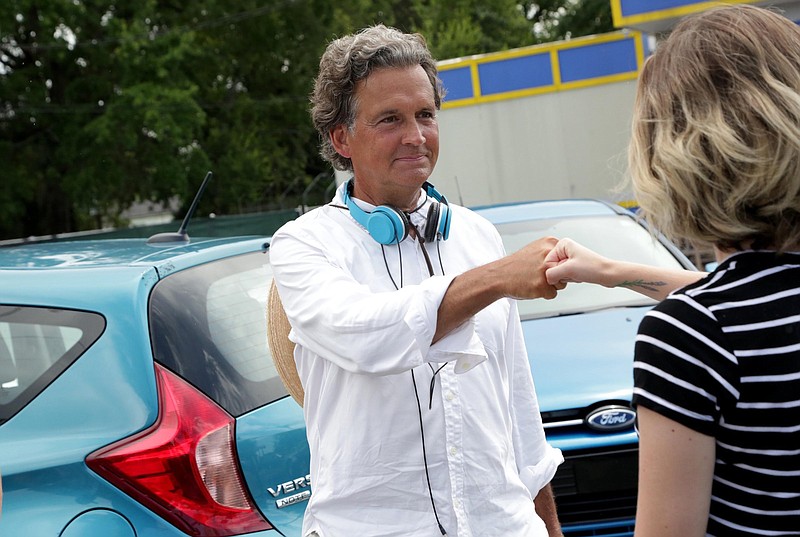Like David Lynch ("Blue Velvet," "Mulholland Drive") and Julian Schnabel ("Before Night Falls," "The Diving Bell and the Butterfly") before him, Bo Bartlett made a name for himself as a painter before making movies. He's made a short documentary, 2018's "Helga," about Helga Testorf, who modeled for fellow artist Andrew Wyeth, who influenced his own work. His debut feature, "Things Don't Stay Fixed," is now available on demand.
While it might not be uncommon for painters to take up a movie camera (both Akira Kurosawa and James Whale were good with a brush), the career shift can take time.
"I started working on it 35 years ago," he said by phone from his Georgia studio. "Writers are told to write what they know, and painters are told to paint in their own backyards. I used the concepts to make a story that I know. I went to film school in 1986 (at New York University) to make this film. When I got out, it was optioned around in Hollywood for a couple of rounds."
The final movie concerns globetrotting photojournalist Sam Grace (William Gregory Lee) who returns to his Columbus, Ga., home town in hopes of stopping his daughter Nina (Melissa Saint-Amand, "Ozark") from getting married before finishing her schooling. The journey forces Sam to re-evaluate his old stamping grounds and to reflect on the choices he has made up until now.
When asked how his movie finally got finished, Bartlett said, "We built the Bo Bartlett center here, part of Columbus State University. It has some of my paintings in it, but it's a national cultural arts center. We'd moved back to help with that. The film industry had moved back to Georgia, coincidentally."
For example, this week's "Coming 2 America" was shot primarily at Tyler Perry's enormous studio in Atlanta.
"The state of the world had changed," he said. "We had a new president. My son, Eliot, who was 27, had passed away. I felt like I needed to take on a new project. I'd been working with a center for the homeless and the incarcerated, but I need a reality to delve into compared to my regular reality. [Screenwriter-playwright] Sandra Deer and I had several screenplays, and I decided to take on the very first screenplay we'd ever finished."
Deer also has roots in Georgia, and Bartlett started collaborating with her after she had experienced some misfortunes. His screenwriting teacher in New York recommended her.
"She said, 'I had just seen a play on Broadway.' It was called 'So Long on Lonely Street,' and she said it was a marvelous play. The night it came out, the critics just blasted it. Within a week, it had closed on Broadway. By the following week, Time and Newsweek had come out with their reviews, and they said it was the best new play of the decade. But by then it was too late because the play had already shuttered," he said. "She said, 'I'd love to take on a new project.' We expected it to be made in a few years. I just emailed her the other day. She can't believe how long it's been."
One change Deer brought to the project was Sam Grace's profession. Because Sam has travelled so much, it's easy to see the connection between him and Bartlett, who has lived in Maine, New York and other locales.
"We didn't want to make him a painter. That would have been a little too autobiographical. Sandra proposed making him a photojournalist, which I loved," Bartlett says. "We wanted him to be involved in the visual world. We wanted to have this union of opposites throughout the whole process: written by a woman, conceptualized by a man. The original idea was that it was a couple going through an estranged marriage. By the time we finished writing it, the wife had disappeared. She'd vanished."
Bartlett's wife, Betsy Eby, serves as executive producer on "Things Don't Stay Fixed."
Even with longtime friends and family and people from his home state to support him, Bartlett said, his new medium came with a learning curve.
He explains, "I'm a very slow simmerer. I can put a little red mark on a painting and sit back and look at it for two hours and say, 'Does that work or not?' I'm alone, and I'm in my studio all day. I've got an immaculate space. There's not a lot of paint on the floor. Everything goes from the palette to the painting. I'm very slow in making my decisions, which drives my wife crazy.
"But I remember when we had our first production meeting on the first day of shooting, I said let's go, and everybody looked at me and said, 'What do we do now?'" He laughed. "I've never done this before. I've never told more than one or two people what to do at a time, much less 75 people what to do. It was a culture shock for sure."
It probably helped that he got some advice from a fellow painter.
"David Lynch sent nice emails encouraging me as we got closer to production. He gave me great working advice. He said, 'Only work with people you like,' then he said, 'Focus on the doughnut, not the hole.' It was wonderful, obtuse advice, but we made a big mantra of it on the wall. Every time there was something we didn't have. Instead of focusing on something that we didn't have like, 'We don't have a lead actor,' we said, 'We've got a movie to make. Let's just move forward.' Things would fall into place, and it was all because of David Lynch's suggestion."
